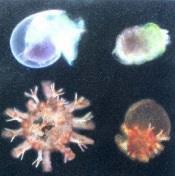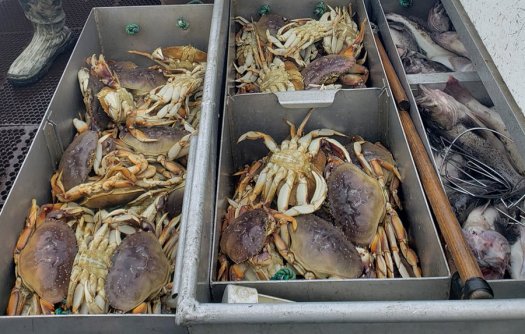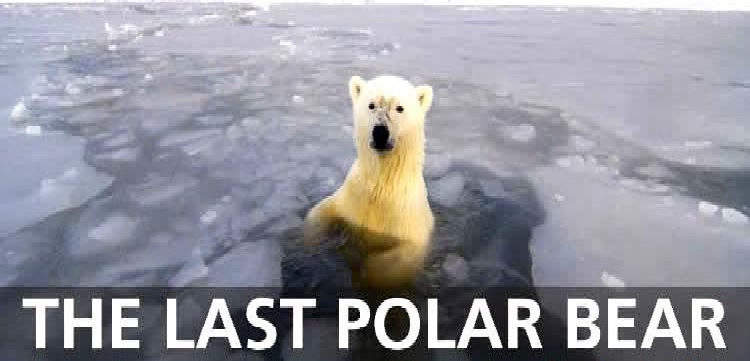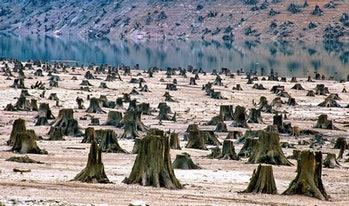“The same oceans that nourished human evolution are poised to unleash misery on a global scale unless the carbon pollution destabilizing Earth’s marine environment is brought to heel.”
United Nations Draft IPCC Report, 2019
In 1866, Svante Arrhenius, a Swedish chemist, estimated that doubling our Earth’s atmospheric carbon dioxide would raise its temperature by 9 degrees F, which is why CO2 and its “associates” are called greenhouse gases (GHG).

Then, in 1958, Dr. Charles Keeling, the American chemist and oceanographer began to record the level of atmospheric CO2 at Hawaii’s Mauna Loa Observatory, which, being 10,300 feet above sea level and far out in the Pacific Ocean, avoided misleading data from mainland sources that could skew his research. Although Keeling proved that CO2 levels were soaring, his work had little influence for more than 20 years.
Acting like blankets, greenhouse gases limit how much of the Earth’s heat can escape into space. If the blanket becomes too thin for too long, too much heat escapes, and an Ice Age follows. However, if it thickens excessively, as it already has, too much heat is trapped, and the Earth develops a fever.
If we give water vapor a rating of 1, carbon dioxide would rate a 5, but methane, (CH4 – the primary component of natural gas), is initially 80 times worse than CO2, averaging 20 times worse as it slowly oxidizes to CO2 and H2O, which takes decades.
However, despite the fact that CO2 is 5 times more potent than water on a molecule to molecule basis, water vapor is a more powerful accelerator of climate change because there is a lot more water vapor, and as the planet warms, even more is created. That extra water vapor traps additional heat, which raises ocean and land temperatures even higher.
A list of Travesty, part 1:
- Alaska – July 3, 2021 – 92 F (33 C) recorded at the Arctic Circle
- Oxygen is declining in lakes
- U.N. says the world is ‘on the verge of the abyss’
- Climate crisis: world is at its hottest for at least 12,000 years – study
- Global Climate Panel’s Report: No Part of the Planet Will be Spared
- Colorado wildfires that scorched up to 1,000 homes and displaced more than 35,000 residents
For millions of years, our planet has been nurtured by a gassy comforter that, like Goldilocks’ bed, has been just right. Those gases have served us well, especially since the last Ice Age, varying only a little while periodically providing nothing worse than a string of harsh winters or abnormally hot summers before returning to normal. That has changed, and the rate of change is rapidly increasing.
Thanks to air trapped in ice from Greenland and Antarctica, we know that the level of atmospheric CO2 has been hovering near 280 parts per million (ppm) since the age of the dinosaurs. However, that number slowly began to rise about 250 years ago when the Industrial Revolution allowed us to burn increasing amounts of carbon. By 1950, atmospheric CO2 levels had reached 300 ppm.
Spurred on by increasing industrialization and burgeoning populations, that number reached 421 ppm in May, 2021. Now that we are no longer hampered by an anti-environment President, his carbon-loving, anti-science cabinet and a badly distracted Congress, we can and must elevate planet above profit if we and the environment that supports us are to survive.
As temperatures rise, heat-reflecting snow and ice become water, which absorbs 90% of the greenhouse gas (GHG) heat and creates water vapor. Warming the oceans increases their volume, which will bring coastal flooding plus serious economic and social upheaval.
Nevertheless, Florida’s Governors have ordered employees to avoid discussing climate change, and Miami is launching a building boom despite street flooding from increasingly higher tides.
The loss of snow and ice exposes land, which, as it warms, produces more water vapor, which brings heavier rains and stronger thunderstorms and tornadoes. In addition, our warming planet will experience a decrease of snowfall, which will reduce the mountain runoff needed to replenish reservoirs that store precious water for agricultural, industrial and personal use.
As the land-based ice in the Antarctic and Greenland melts, rising sea levels will destroy coastal cities, create millions of refugees and cause civil unrest. The insurance industry knows this, and it has already begun to adjust its rates.
Rising seas will displace 300 million people by 2050
International Panel on Climate Change
A list of Travesty, part 2:
- Scientists Warn of Looming Collapse of Civilization
- Moodys Warns Cities to Address Climate Risks or Face Downgrades
- Sea Level Rise Will Be Worse and Come Sooner
- NASA Video: Reshuffling Heat on a Warming Planet
- Climate crisis: world is at its hottest for at least 12,000 years – study
The world is at its hottest for at least 12,000 years
The Guardian, 2021
For eons, Nature has relied on three primary methods to capture CO2. The first is photosynthesis by forests, crops and ocean plants that range from huge kelp “forests” to tiny phytoplankton, but we are clear-cutting forests equal in area to West Virginia every year while polluting our oceans. The second also involves the oceans, which can absorb huge amounts of CO2, and the third depends on CO2-hungry basalts that have been stripped of their carbon dioxide by the heat of volcanoes.
However, adding CO2 to water creates carbonic acid, which impedes the formation of the calcium carbonate shells of crabs, shrimp, lobsters, oysters, scallops, and most importantly, tiny organisms like the phytoplankton that comprise the foundation of the ocean food chain.
Acidifying our oceans is already causing greater damage than sea level rise, and it will have far more serious consequences.
We now have evidence that the concentrations of CO2 and other greenhouse gases will, within a few decades, equal those that caused the Permian extinction that occurred some 250 million years ago – when more than 90% of all oceanic species died due largely to huge eruptions of CO2 and methane in Siberia.
Because these conditions developed over hundreds of thousands of years, many organisms had time to evolve, but our anthropogenic (human-caused) Climate Change, being much more rapid, will leave too little time for many species to evolve. (The Cretaceous-Paleogene die-off 56 million years ago also followed a significant drop in the pH of the oceans.)
Like it or not, the problems we face are the direct result of our creating 2.1 trillion tons of Industrial Age CO2, to which we are adding 50 billion tons per year. Only 1/3 of that CO2 has dissolved in our seas, and as the remainder is absorbed, our oceans will become even more acidic (less alkaline) and increasingly hostile to life.

Our oceans have been slightly basic for millions of years, having an average pH of 8.2. (7.0 is neutral, being neither acid nor basic). However, in the last 250 years, our excesses of CO2 have made our oceans more acidic as their pH has dropped from 8.2 to 8.1.
That might seem trivial, but because the pH scale is logarithmic, not linear, this represents a large increase toward acidity, and a pH of 8.0 or 7.9 couldl mean death to many species, including phytoplankton, and near-death to the oceans that provide 20% of our protein and 50% of our oxygen.
Even if we stop burning carbon today, we will still have almost 1.2 trillion tons of excess, man-made CO2 in our atmosphere to deal with. It is no exaggeration to say that we only have about 15 years, not decades, to prevent the next 0.1 drop in pH.
“It is not up for debate: It is a cold, hard fact that both climate change and ocean deoxygenation are happening.”
Ocean Scientists for Informed Policy

to Suffocating by 2030 – by A. Haro – The Inertia
If we continue on the road we are on, the oceans could begin to suffocate in 15 years.
Matt Long, National Center for Atmospheric Research
A list of Travesty, part 3:
- Ocean Deoxygenation And Its Effect On The Marine Ecosystem
- Sea Life in the Pacific Ocean Will Start to Suffocate by 2030 Thanks to Climate Change
- Study Finds Ocean Acidification Rate is Highest in 300 Million Years, CO2 is Culprit
Since 1980, we have melted 72% of the Arctic’s ice, and in 2014, scientists at California’s Jet Propulsion Laboratory who monitor the rate of arctic melting reported that at least 50 cubic miles of the Greenland ice sheet melted during just 2013. And in early April, 2017, the Coast Guard International Ice Patrol, which tracks icebergs, sighted 450, which is far more than the historical average of 83 in the same area at that same time of year.
Icebergs
As the Arctic warms, the tree line is slowly moving north, as are robins, black bears and a host of “southern” insects. I have seen these changes and many more.
Beginning in 1961, I spent parts of the next 38 summers “bush flying” in northern Canada and Alaska. There, winters are now at least five weeks shorter than they were just 50 years ago, and the shrinking ice pack is leaving many polar bears insufficient time to fatten up on seals, with some bears coming off of the springtime ice severely underweight. Some are drowning, having become too weak to survive what was once an easy 100-mile swim to shore for a healthy bear.
Once ashore, these weakened bears face a new hazard: Grizzly bears are expanding their range, and even a healthy polar bear is no match for a grizzly.
When the winter of 2016 began, the North Pole was 36 degrees F above normal, and in July, 2017, an ice shelf the size of Delaware broke free from Antarctica.
With NOAA reporting that 2019 was, globally, the hottest year ever recorded, (with arctic temperatures running as high as 16 degrees F above normal), and that 2020 has been the hottest on record, what hope is there for these magnificent animals – and for many other species that are not as photogenic or obvious? In March, 2020, Antarctica broke previous records with a high of 68 degrees F.

In Oregon, Washington and British Colombia, oyster farmers must now add lime to their tanks of ocean water to counter its increasing acidity. And according to the World Wildlife Fund, over fishing just between 1970 and 2014 has reduced the number of fish and other ocean species by 50%, with tuna and mackerel down by 74%. In addition, several new studies show that even current levels of oceanic CO2 can even “intoxicate” fish, which can impact their ability to survive.

The year scale in this image ranges from 1850 to 2100. The dark blue line shows decreasing pH – increasing acidity – and the green line reveals the decrease in carbonate available for making shells. In the chart, “NOW” is 2014. We will be farther down the dark blue line when you read this book.
In 2014, Canadian scientists discovered that the volume of arctic phytoplankton had dropped an alarming 40% since 1950, and since then it has continued to drop by 1% per year.
Why should we care about these tiny organisms? Because phytoplankton provide the base of the food pyramid that sustains most oceanic life, and no phytoplankton will eventually mean “no fish.” In addition, as previously noted, phytoplankton produce 50% of our oxygen and consume most of the carbon- dioxide we produce by using carbonates to build their shells.
When they die, their tiny shells accumulate on the ocean floor, eventually becoming limestone – the end result of the most effective carbon sequestration process on earth. That process can sequester a billion tons of CO2 per year, which sounds impressive, but, as noted earlier, we are emitting 50 billion tons of CO2 every year. Worse yet, since prehistoric times, the amount of oxygen in our atmosphere has declined by a third, almost entirely due to deforestation and the decrease in phytoplankton.
Carbon emissions are acidifying the ocean so rapidly that the seafloor is disintegrating.
National Academy of Science, 2018
Australia’s Great Barrier Reef is 50% dead. Caribbean corals are 80% dead (PBS May, 2021). By 2050, shellfish calcification and survival could become impossible. Our carbon dioxide emission rate is even greater than the volcanic emission rate that caused the Permian extinction 250 million years ago when the world lost 90% of its species.
A list of Travesty, part 4:
- The North Pole is an insane 20C warmer than normal as winter descends
- Earth is now losing 1.2 trillion tons of ice each year. And it’s going to get worse
- Ocean Acidification Is Literally Dissolving The Shells Of Dungeness Crabs
- Ocean acidification may cause dramatic changes to phytoplankton
- What is a dead zone?
- Ocean Acidification Threatens Entire Ecosystems
- Latest numbers show at least 5 metres sea-level rise locked in
- Dahr Jamail | Great Barrier Reef Reaches “Terminal Stage” as CO2 Levels Rise at Record Rate
- Scientists say a dramatic worldwide coral bleaching is now underway
- Great Barrier Reef Suffered Worst Coral Die-Off on Record in 2016
Even if we find a way to emit less CO2 than is being absorbed, our oceans will continue to acidify because the CO2 we have already created will persist in our atmosphere for hundreds of years, and in the oceans for tens of thousands of years, which is why we must develop some form of corrective geo-engineering. However, that will require huge amounts of CO2-free, non-polluting nuclear power.
Reducing acidification must become a worldwide priority if we are to avoid a life-changing oceanic and humankind disaster. Extinctions of sea life are certain if we do nothing.
Barbara Ward
“We cannot cheat on DNA. We cannot get around photosynthesis. We cannot say I am not going to give a damn about phytoplankton. All of these mechanisms provide the preconditions of our planetary life. To say we do not care is to say that we choose death.”
Potential Remedies by Dr. Alex Cannara
1. Mimic the natural carbon sequestration process of the oceans: Use CO2-free, highly efficient nuclear energy to heat limestone or dolomite to release lime (calcium oxide and magnesium oxide), which we distribute across the ocean to neutralize the carbonic acid. The CO2 produced when limestone is heated would be sequestered in porous basalt, with which it chemically combines. Refining enough lime from limestone will require about 900 1-Gigawatt (GW) nuclear plants, and that’s only enough to neutralize our present emissions.
[A team led by Dr. Ken Caldeira, a climate scientist at the Carnegie Institution for Science, used an alkaline substance to alter the chemistry of seawater at a small atoll in Australia’s Great Barrier Reef. The resulting decrease in seawater acidity mimicked pre-industrial ocean conditions – so this remedy could work.]
[If we had adopted the Atomic Energy Commission’s 1962 recommendation to expand nuclear power, we’d already have those nuclear plants, we’d have created less CO2, and we’d have saved MILLIONS of lives that have been lost due to carbon-related pollution.]
2. Spread finely ground basalt into the oceans. Basalt, which is created by volcano1es, is “carbon hungry,” so basalt would remove CO2 from the oceans. Lime and basalt, being basic, would assist shell formation by neutralizing the carbonic acid. Volcanic ash, which is primarily powdered basalt, can also be used to improve soil quality, so scattering “powdered” basalt across farm fields could help remove the excess carbon dioxide from our troubled atmosphere.
“Our current anthropogenic carbon dump rate is about 33.4 gigatons of CO2/year. Each ton of powdered basalt can “fix” about 0.2 tons of carbon (0.73 tons CO2), so we’ll need to mine, grind, and disperse about 46 billion tons of basalt powder/yr to keep up with our current CO2 dump rate (about the total amount of sand & gravel now mined/yr). At 100 kWhr/ton, the power needed to convert that much rock to powder would require the electrical output of 500, 1 GWe nuclear reactors. However, basalt contains many minerals, some of which might be harmful to sea life, so basalt might have to yield to lime, which is as natural as the organisms that incorporate it in their carbonate shells and skeletons. In any case, marine biologists should oversee these actions and the production of the materials.
“For this to work on land, fields should be warm, watered, tilled and biologically active. The world’s 400 million acres of rice fields seem to fit that bill. Land currently devoted to corn and soybean production would probably also be suitable.
“This approach is more affordable than scenarios that invoke electrochemistry or the calcination of limestone. In addition, it would appeal to countries that want to increase agricultural productivity.
3. “Pump water and CO2 from the air into the basalt that underlies huge areas of the globe. The volcanic basalt, will combine with the carbonic acid to LOCK UP the CO2. This is not same as just pumping compressed CO2 down a hole and hoping it stays there.“Iceland studies reveal that up to about 150 pounds of CO2 can be stored in just one cubic meter of basalt, and if we could also apply this process to the basalt in ocean ridges, we could sequester the 5,000 Gigatons of CO2 created by burning all of the fossil fuel on Earth. If this were done worldwide, it could drastically shorten the timescale of carbon trapping. Instead of taking centuries, CO2-trapping via basalt carbonation could be completed within a few decades, but it will require huge amounts of CO2-free electrical power.” In 2017, scientists at Caltech and USC found a way to speed up part of the reaction that helps sequester CO2 as limestone in the ocean. By adding the enzyme carbonic anhydrase, the researchers made the sequestering process proceed 500 times faster, and in 2018, a new process for sequestering carbon dioxide in concrete was developed.
Climate Change Will Cost Us Even More Than We Think
We must also electrify cement making, which requires huge amounts of energy, by using electricity generated by CO2– free nuclear power, then sequester the CO2 released during the process in basalt and use the lime to assist the ocean.
To summarize: Our planet’s ocean life can sequester a billion tons of CO2 per year by making shells, skeletons, limestone, etc. However, the 1/3 of the 2 trillion tons that the ocean has already absorbed has already lowered ocean pH close to extinction levels for many organisms.
Ocean warming has worsened the threat, and 2050, not 2100, is the key oceanic end-of-life date, and this doesn’t include the warming caused by methane liberated by thawing permafrost and sub-sea methane hydrates.
Therefore, getting CO2 levels down to 350 is probably meaningless if we don’t protect ocean chemistry.
To sequester CO2 one must chemically remove about 500 CO2 molecules from every 1,000,000 molecules of air – and then store them FOREVER.
We will also need to connect the removal sources to basalt formations that permanently store CO2 as rock. Then, we must address methane leakage, which is adding about 200 ppm of equivalent CO2 to the air because our natural gas wells and our porous distribution systems are leaking so severely.
We must get serious. Our yearly 40+ trillion tons of CO2 emissions have already brought ocean chemistry 2/3 of the way to the death of the oceans that create 50 % of our oxygen.
Bad news: If we add the effects of methane leaking from fracking wells and our porous distribution system, and methane released from thawing permafrost, our May, 2021 CO2 level of 421 ppm would, in effect, be over 500.
More bad news: Because humans cool their bodies by sweating, rising heat and humidity will increase stress while decreasing comfort and efficiency. Further increases will cause medical issues that can even be fatal.
Even more bad news: 50 % of the Arctic’s shallow permafrost is predicted to thaw by 2100. As it does, some of its 40 million gallons of previously immobilized, hazardous mercury will be released into the polar ocean and the atmosphere.
At least 30,000 plant and animal species are threatened with extinction.
Center for Biological Diversity, 2020
A list of Travesty, part 5:
- As Nuclear Struggles, A New Generation Of Engineers Is Motivated By Climate Change
- Ocean Shock – Reuters reveals the climate crisis beneath the waves. Driven by warming waters, marine life is on the move — and life on land is forever change
- The Next Disaster Coming to the Great Plains
- When Rising Seas Transform Risk into Certainty
- Think Covid-19 Disrupted the Food Chain? Wait and See What Climate Change Will Do
- Warming climate will displace millions in coming decades: World Bank
- U.S. Military Could Collapse Within 20 Years Due to Climate Change, Report Commissioned By Pentagon Says
Climate Forecast: World Is “Sleepwalking into Catastrophe”
Scientific American, 2019

In 1942, the St Roch became the first vessel to transit the Northwest Passage from West to East, but it took the small, shallow-draft vessel 2 years.
Large ship travel through the Passage is now common.
What we have been doing is like “taking a one-week fling, and, in the process, contracting a horrible disease.”
Bill McKibben
Dr. James Hansen, former chief climate scientist at NASA, now chief climate scientist at Columbia University, is well known for bringing definitive evidence of global warming to Congress in 1988:
“Environmentalists and world leaders must accept nuclear power now to avoid catastrophic climate change…Mass species extinction, extreme weather events, dry spells and fires are climate change impacts which are happening now.
“A warmer atmosphere and warmer oceans can lead to stronger storms,” he explained. (Superstorm Sandy, for example, remained a hurricane all the way up the Eastern seaboard to New York because Atlantic waters were abnormally warm.)
Planet is trapping almost twice as much heat in atmosphere as it did 15 years ago.
NASA, 2021
“Amplifying impacts” and feedback loops will accelerate the changes, says Hansen. “It will happen faster than you think,” he said. (If major coastal cities become dysfunctional because of sea level rise, which he believes is possible, the global economy could be in peril of collapse.)
A list of Travesty, part 6:
- Our climate models could be missing something big
- 6th mass extinction happening now? These scientists say yes
- Global heating pushes tropical regions towards limits of human livability
Only when the last tree has died, the last river has been poisoned and the last fish has been caught, will we realize that we cannot eat money.
– Cree Indian Proverb

Want to stop climate change? It’s easy: Embrace the nuclear option.
Coming up next week, Episode 6 – The Big Melt and The Acid Bath.
Links and References
- Next Episode – Episode 6 – The Big Melt and The Acid Bath
- Previous Episode – Episode 4 – Fossil Fuel Frolics
- Launching the Unintended Consequences Series
- Dr. George Erickson on LinkedIn
- Dr. George Erickson Website, Tundracub.com
- The full pdf version of Unintended Consequences
- Dr. Charles David Keeling Biography
- https://www.hcn.org/issues/53.3/south-colorado-river-will-the-climate-crisis-tap-out-the-colorado-river
- https://en.wikipedia.org/wiki/Svante_Arrhenius
- https://www.theguardian.com/environment/climate-consensus-97-per-cent/2015/jun/15/the-latest-global-temperature-data-are-breaking-records
- https://phys.org/news/2021-06-world-lakes-oxygen-rapidly-planet.html
- https://www.yahoo.com/news/as-biden-prepares-for-climate-summit-un-says-the-world-is-on-the-verge-of-the-abyss-194222171.html
- https://www.theguardian.com/environment/2021/jan/27/climate-crisis-world-now-at-its-hottest-for-12000-years
- https://insideclimatenews.org/news/09082021/global-climate-panels-report-no-part-of-the-planet-will-be-spared-ipcc-science-cop-extremes/
- https://www.yahoo.com/news/photos-show-devastating-colorado-wildfires-200444690.html
- https://www.commondreams.org/news/2021/01/13/dire-assessment-scientists-warn-humanity-denial-looming-collapse-civilization-we
- https://www.bloomberg.com/news/articles/2017-11-29/moody-s-warns-cities-to-address-climate-risks-or-face-downgrades
- https://www.insurancejournal.com/news/national/2016/04/12/405089.htm
- https://www.facebook.com/watch/?v=1133593866707256
- https://www.theguardian.com/environment/2021/jan/27/climate-crisis-world-now-at-its-hottest-for-12000-years
- https://www.ecoshock.org/2021/03/billion-dollar-black-out-climate-disasters.html?
- https://www.oceanscientists.org/ocean-deoxygenation/
- https://www.newsweek.com/pacific-ocean-deoxygenation-2030-climate-change-454157
- https://obamawhitehouse.archives.gov/blog/2012/03/13/study-finds-ocean-acidification-rate-highest-300-million-years-co2-culprit
- https://www.navcen.uscg.gov/?pageName=IcebergLocations
- https://nsidc.org/cryosphere/quickfacts/icesheets.html
- https://www.navcen.uscg.gov/pdf/iip/outlook/IcebergOutlook.pdf
- https://www.facebook.com/kerstin.langenberger.photography
- https://www.noaa.gov/
- https://www.smh.com.au/environment/weather/the-north-pole-is-an-insane-20c-warmer-than-normal-as-winter-descends-20161118-gss3bg.html
- https://www.washingtonpost.com/climate-environment/2021/01/25/ice-melt-quickens-greenland-glaciers/
- https://sfist.com/2020/01/26/ocean-acidification-is-literally-dissolving-the-shells-of-dungeness-crabs/
- https://phys.org/news/2015-07-ocean-acidification-phytoplankton.html
- https://oceanservice.noaa.gov/facts/deadzone.html
- https://www.ecowatch.com/ocean-acidification-oregon-2646837418.html
- https://www.newscientist.com/article/mg22630253-300-latest-numbers-show-at-least-5-metres-sea-level-rise-locked-in/
- https://truthout.org/articles/great-barrier-reef-reaches-terminal-stage-as-co2-levels-rise-at-record-rate/
- https://www.washingtonpost.com/news/energy-environment/wp/2015/10/08/scientists-say-a-dramatic-worldwide-coral-bleaching-event-is-now-underway/
- https://truthout.org/articles/great-barrier-reef-suffered-worst-coral-die-off-on-record-in-2016-new-study/
- https://www.youtube.com/watch?v=GL7qJYKzcsk
- https://www.youtube.com/watch?v=kQMZfCKuFIQ
- https://en.wikipedia.org/wiki/Barbara_Ward%2C_Baroness_Jackson_of_Lodsworth
- https://www.linkedin.com/in/alex-cannara-6a1b7a3
- https://www.linkedin.com/in/ken-caldeira-2a45648/
- https://carnegiescience.edu/
- https://www.nature.com/articles/nature.2016.19410
- https://www.smithsonianmag.com/innovation/combat-climate-change-researchers-want-to-pull-carbon-dioxide-from-ocean-and-turn-it-into-rock-180977903/
- https://agupubs.onlinelibrary.wiley.com/doi/full/10.1002/rog.20004
- https://www.nytimes.com/2019/10/23/opinion/climate-change-costs.html
- https://www.npr.org/2018/06/15/619348584/as-nuclear-struggles-a-new-generation-of-engineers-is-motivated-by-climate-change
- https://www.reuters.com/investigates/section/ocean-shock/
- https://www.theatlantic.com/ideas/archive/2021/12/kansas-aquifer-ogallala-water-crisis-drought/621007/
- https://www.nytimes.com/2017/04/18/magazine/when-rising-seas-transform-risk-into-certainty.html
- https://insideclimatenews.org/news/07072020/coronavirus-agriculture-food-chain-future-climate-change/
- https://www.straitstimes.com/world/united-states/warming-climate-will-displace-millions-in-coming-decades-world-bank
- https://www.vice.com/en/article/mbmkz8/us-military-could-collapse-within-20-years-due-to-climate-change-report-commissioned-by-pentagon-says
- https://www.linkedin.com/in/bill-mckibben-6174131b7/
- https://350.org/bill/
- https://twitter.com/DrJamesEHansen
- https://www.theatlantic.com/magazine/archive/2021/03/extreme-climate-change-history/617793/
- https://eu.usatoday.com/story/opinion/2020/01/22/climate-change-solution-nuclear-energy-our-best-hope-column/2821183001/
- https://earthsky.org/earth/6th-mass-extinction-in-progress-invertebrates/
- https://www.theguardian.com/science/2021/mar/08/global-heating-tropical-regions-human-livability
#ClimateChange #UnintendedConsequences #GeorgeErickson #FissionEnergy #NuclearEnergy #FossilFuels















2 Replies to “Episode 5 – The Big Melt and The Acid Bath – Unintended Consequences – Chapter 1”